
Birds at parks in long-term decline
Women no longer wear hats embellished with feathers for fashion. Plume-hunting is currently illegal in the Everglades. Birds in the Everglades are no longer in danger. Right?
Wrong.
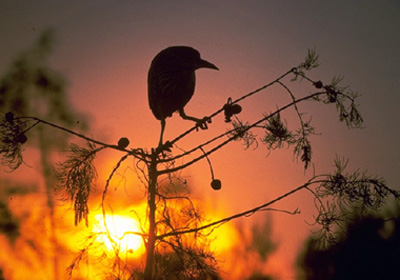 |
Wildbirds are on the decline in Everglades National Park in South Florida (Photos courtesy of the National Park Service). |
Although the Everglades National Park is no longer subject to hunting, the unnatural distribution and quality of water has contributed to the decline of several bird species devaluing the park’s association with 350 different species of feathered creatures.
“While a few species seem to be rebounding, others, such as the roseate spoonbill, are continuing their downward spiral,” said Larry Perez, a member of the South Florida Natural Resources Center’s Science Communications Outreach, the largest science center of the National Park Service.
The most drastic and recent drop of all is that of the roseate spoonbill. With the worst drop in breeding season in Florida Bay in over 40 years, the species is disappearing. Florida Bay takes up one-third of the Everglades.
As wading birds, like the popular ibis of the Everglades, these animals have long legs for wading in the water to catch their fish. In the shallow water, the spoonbill lowers its partially opened bill and snaps it shut once a small fish or source of food has triggered its sensitivity.
| An anhinga dries his feathers in a tree at Everglades National Park (Photo courtesy of the National Park Service). | 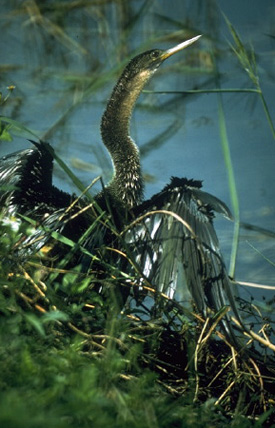 |
The technique, also known as “tacto-location,” is most effective at low water levels. However, with water being dumped into the Everglades during the natural dry season to prevent flooding in areas, fish are no longer concentrated in small shallow pools, leaving the spoonbills and other wading birds hungry and fending for survival.
According to Jerry Lorenz, state director of research for Audubon of Florida who has monitored the species, the spoonbills have been nesting in Tampa Bay rather than Florida Bay. The birds, serving as indicators of the Everglade’s health, show that it is a larger matter–that of this ecosystem’s need for water control.
“The large-scale modifications we’ve made to the hydrology of South Florida often render the area inhospitable to the continued reproduction of wading birds,” said Perez. “South Florida’s web of canals, levees and water control structures were constructed primarily for two important uses: flood control during times of high water and water delivery during the dry season.”
The Everglades, distinct in the sense that it has a wet season and a dry season that the animals are conditioned to adapt to, is not being supplied with its natural flow. With South Florida’s population of over six million people and a water management system that was designed to serve two million, the Central and Southern Florida (C&SF) Project has been forced to meet the growing demand of other supply needs.
“The failure to allot the appropriate quantity, quality, timing and distribution of water necessary to sustain South Florida’s natural areas has remained a constant issue with the current design of the system,” said Perez.
Several projects, though, are under way.
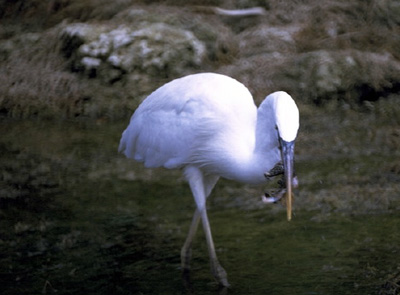 |
A great white heron, which is actually a color variation of the great blue heron, Ardea herodias, in the Everglades (Photo courtesy of the National Park Service). |
“We are in the midst of the 40-year Comprehensive Everglades Restoration Plan (CERP), which aims to correct many of these design features. But until they are implemented, water managers are left with few choices when trying to provide water supply and flood protection to the South Florida community,” said Perez.
Legislation passed by the U.S. Congress in November, the 2007 Water Development Resources Act, allows for approved funding of $1.8 billion for three significant restoration projects: Indian River Lagoon-South which restores an estuary vital to the homes of 4,300 species, Picayune Strand Hydrologic Restoration which improves groundwater and uplands, and the Site 1 Impoundment which allows for water storage that would otherwise be dumped into the Atlantic Ocean.
Non-wading birds, along with wading birds are affected as well.
According to Perez, the Everglades Kite, the Bald Eagle and the Cape Sable Seaside Sparrow have also diminished in numbers. Habitat loss and pesticides are to blame, such as the use of DDT, which is now illegal and mercury pollution from unknown sources.
“There are a number of both governmental and non-governmental organizations dedicated to all the causes that affect the Everglades,” said Perez. “In addition to the park service, the U.S. Fish and Wildlife Service, Florida Fish and Wildlife Conservation Commission and Florida Department of Environmental Protection.”
Another organization, Friends of The Everglades, has filed or joined ten lawsuits in the last 10 years for the cause. Currently, it is involved in four. Two are against the SFWMD for dumping polluted water, another against the EPA for not reviewing water quality standards and another against the U.S. Army Corps of Engineers. However, it is not dedicated to fixing the natural flow of the Everglades water supply.
| An American woodstork, Mycteria americana, in the Everglades (Photo courtesy of the National Park Service). | 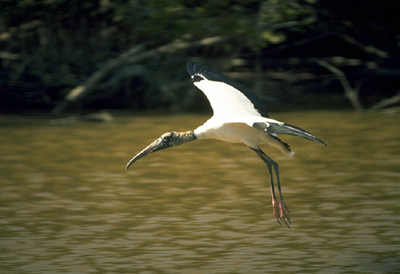 |
“In fact, not much of Friends’ work has focused on the water flow issues during the past several years, and as you know the water supply issues have been primary for the wading birds–we’ve been having an internal discussion for the past few months about the extent to which Friends should return to those water supply questions,” said Joe Bowder, a board member of Friends of the Everglades and an energy/ environmental consultant.
While all restoration projects and studies seem promising for many species of the Everglades, Lorenz emphasized the need to push the politics behind these projects.
“It’s not just about the animals, it’s about the economy,” said Lorenz. “There are $50 million that come in from commercial fish landings that will not be there.”
There won’t be fish, shrimp or any such species to support the cause financially. The longer the politics behind these projects takes, the worse the situation gets.
According to Bowder, Friends of The Everglades was one of the few organizations to oppose the overall 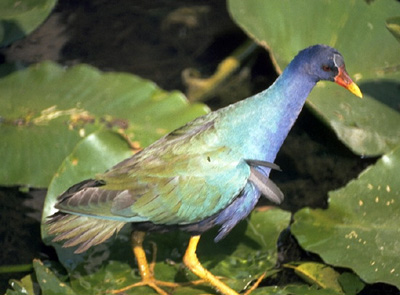 Everglades restoration program (CERP).
Everglades restoration program (CERP).
“The ‘restoration’ plan actually gives priority to more water supply for the cities and more control over the entire system to the EAA landowners, with the needs of the natural Everglades coming in a distant third, and only the needs of the major Everglades habitats given serious legal habitat protection,” said Bowder.
Hopefully the ongoing political conflict behind the scenes of restoration projects will quickly be resolved in order to restore the natural quality of the birds’ habitat.
“Right now, the Everglades is not a river. It’s broken into pieces. The species will keep going away as it is not fixed,” said Lorenz. “If restoration is done correctly, it can be helped.”

Comments are Closed